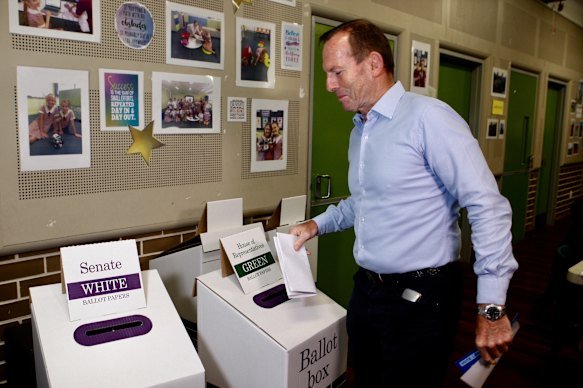Former Australian prime minister Tony Abbott voting in his electorate of Warringah in 2019.Credit: Dean Sewell
So voters switch sides, pushing policy back towards the ordinary voter’s view. The more extreme we go in one direction, the more extreme the pushback – think of Tony Abbott winning a landslide in 2013 then, after an austerity budget, being turfed out less than two years into his term.
If you buy that, expect 2025 to be Albanese’s high-water mark.
Thermostasis “helps to explain why sometimes views appear to regress – some voters think immigration or feminism have ‘gone too far’,” says Dr Jill Sheppard, a senior lecturer in the School of Politics at the Australian National University.
But it doesn’t explain our politics as well as it does America’s because our party system means leaders are limited in their ability to “overshoot” public views and become too extreme. “You’ll lose your job before voters get a chance to turn on you,” Sheppard says.
Explanation two: Long-term structural changes
Sheppard and Ian McAllister, distinguished professor of political science at the Australian National University, are part of a team tracking political sentiment via the long-running Australian Election Study.
From that perch, McAllister doesn’t see a thermostatic electorate constantly pulling policy towards the centre; he sees an electorate “moving gradually to the centre-left”.

Young Greens supporters cheer at campaign HQ in Melbourne.Credit: Paul Jeffers
The study puts this shift about 0.5 points (out of 10) from right to left since 1996 – and closer to 1 per cent if you just look at young voters.
Before Saturday’s election, Dutton said he expected younger Greens voters would “mature politically” into Coalition supporters. But this idea – that voters change how they vote as they age – has long been called bunkum by political scientists. Instead, it is who you cast your first adult vote for that significantly sets the tone for the rest of your voting life.
Loading
This has long-term structural implications. In 2022, the Coalition had the lowest recorded vote share among voters under 40 for a major party in the history of the Australian Election Study. “I’m sure when we get our 2025 data, it will be even more pronounced,” says McAllister.
But we are also seeing a dramatic increase in “electoral volatility”. Voters are much more willing to change their vote, and to vote for minor parties. In 1967, 72 per cent of all voters said they hadn’t changed their vote in their lifetimes. In 2022, that had fallen to 37 per cent.
This hurts both parties, but it hurts the Coalition more. Labor voters tend to move to the Greens, their preferences flowing back to Labor; Coalition voters tend to move to other minor parties or independents.
Loading
And there’s a third trend McAllister sees – perhaps the most-fascinating.
We can often focus more on politics than policy with the expectation voters don’t care that much about the details. But this is changing. As voters become more educated, they start to take a keener interest in policy itself. “It’s been one of the big changes we’ve seen over the past 30 years,” says McAllister.
Between half and two-thirds of voters say they base their vote on policy, not politics. Given how policy-lite our current politics are – a quarter of voters said there was no difference between the parties at the 2022 election – there seems an obvious strategy here for either party to win voters back. Just write good policy!
Read the full article here
